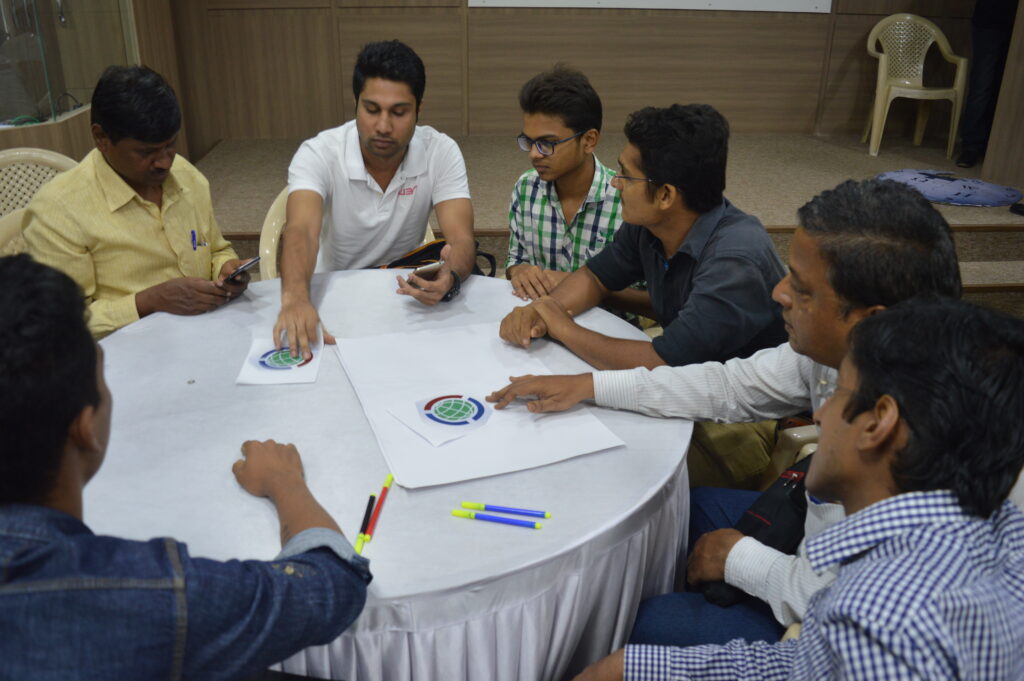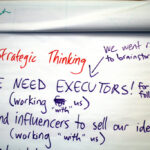What is brainstorming? Techniques and Methods
In the dynamic landscape of problem-solving and creativity, one technique stands out: brainstorming. It’s a collaborative and spontaneous approach that has been a cornerstone in generating ideas and solving complex challenges. Let’s dive into the world of brainstorming, exploring its origins, techniques, and methods that make it an invaluable tool.

Table of Contents
I. Introduction
A. Definition of Brainstorming
Brainstorming is a creative problem-solving technique that involves generating a large number of ideas within a group. The emphasis is on quantity over quality during the initial phase, encouraging a free flow of thoughts without criticism.
B. Importance of Brainstorming
The significance of brainstorming lies in its ability to unlock creativity, promote team collaboration, and provide innovative solutions to problems.
II. Historical Perspective
A. Origin of Brainstorming
Brainstorming was first introduced by Alex Faickney Osborn in the late 1930s. Initially called “thinking up,” the approach aimed to encourage creative thinking in groups.
B. Evolution over Time
Since Osborn’s inception, brainstorming has evolved, adapting to different industries and challenges. Various modifications and methods have emerged, shaping its effectiveness.
III. Benefits of Brainstorming
A. Enhancing Creativity
Brainstorming cultivates a creative environment where participants feel free to express unconventional ideas, fostering innovation and out-of-the-box thinking.
B. Fostering Team Collaboration
The collaborative nature of brainstorming enhances teamwork, breaking down silos and ensuring diverse perspectives contribute to the collective effort.
IV. Techniques of Brainstorming
A. Traditional Brainstorming
Classic brainstorming involves a group gathering to generate ideas spontaneously. No criticism is allowed during this phase, ensuring a free flow of thoughts.
B. Mind Mapping
Mind mapping is a visual brainstorming technique that helps organize and connect ideas in a structured manner, aiding in the development of comprehensive solutions.
C. Reverse Brainstorming
This innovative approach involves identifying problems instead of solutions, allowing teams to explore challenges from different angles and uncover unique insights.
V. Methods for Effective Brainstorming
A. Setting the Right Environment
Creating a conducive environment is crucial for successful brainstorming. Comfortable spaces, whiteboards, and inspiring visuals contribute to a creative atmosphere.
B. Encouraging Divergent Thinking
Divergent thinking is the backbone of brainstorming, encouraging participants to explore various perspectives and ideas without limitations.
C. Leveraging Technology
In the digital age, technology plays a vital role in brainstorming. Online collaboration tools and virtual brainstorming sessions break down geographical barriers.
VI. Common Challenges in Brainstorming
A. Overcoming Resistance
Resistance to new ideas is a common challenge. Encouraging an open-minded culture and showcasing successful outcomes can mitigate such resistance.
B. Dealing with Groupthink
Groupthink can hinder the diversity of ideas. Fostering an inclusive environment where everyone feels heard helps combat groupthink and ensures a richer brainstorming experience.
VII. Case Studies
A. Successful Brainstorming Sessions
Exploring instances where brainstorming led to successful outcomes, highlighting the impact of diverse thinking in problem-solving.
B. Lessons Learned from Failures
Analyzing cases where brainstorming fell short, drawing lessons to refine future approaches and enhance the effectiveness of sessions.
VIII. Brainstorming for Different Purposes
A. Business Strategy
How brainstorming contributes to the development of innovative business strategies, providing a competitive edge in the market.
B. Problem Solving
The role of brainstorming in tackling complex problems, offering insights and solutions that traditional approaches might overlook.
C. Innovation and Product Development
Innovation is at the core of brainstorming, influencing product development and enhancing the overall creativity of a company.
IX. Combining Brainstorming with Other Approaches
A. Design Thinking
The synergy between brainstorming and design thinking, exploring how these methodologies complement each other for comprehensive problem-solving.
B. Six Thinking Hats
A method that adds structure to brainstorming by assigning participants different perspectives, ensuring a well-rounded exploration of ideas.
X. Neuroscientific Insights into Brainstorming
A. Brain Functions during Creative Sessions
Understanding how the brain operates during brainstorming sheds light on the neurological processes that contribute to creative thinking.
B. Neurological Benefits of Brainstorming
Exploring the positive impact of brainstorming on cognitive functions and mental well-being, providing a holistic view of its benefits.
XI. Incorporating Brainstorming in Education
A. Classroom Applications
How educators can harness the power of brainstorming to engage students, encourage critical thinking, and promote a collaborative learning environment.
B. Student Engagement
The role of student engagement in effective brainstorming, emphasizing the importance of creating a supportive and inclusive educational atmosphere.
XII. Future Trends in Brainstorming
A. Technological Advancements
The integration of AI and other technological advancements in brainstorming processes, shaping the future landscape of creative problem-solving.
B. Integration with AI
Exploring how artificial intelligence can enhance brainstorming by providing data-driven insights and aiding in the ideation process.
XIII. Real-life Success Stories
A. Companies Embracing Brainstorming
Highlighting organizations that have successfully embraced brainstorming, showcasing the positive impact on their culture and bottom line.
B. Impact on Organizational Culture
Examining how a culture of brainstorming contributes to an innovative and adaptive organizational culture.
XIV. Tips for Hosting Effective Brainstorming Sessions
A. Facilitator’s Role
The key responsibilities of a facilitator, including fostering inclusivity, managing time effectively, and guiding the group towards productive outcomes.
B. Establishing Clear Goals
Setting clear goals for each brainstorming session ensures focus and direction, maximizing the effectiveness of the collaborative effort.
10 effective techniques of brainstorming:
1. Free Writing: Free writing involves jotting down ideas without concern for grammar or structure. This uninhibited approach allows a free flow of thoughts, fostering creativity and opening doors to unexpected solutions.
2. Mind Mapping: Mind mapping visually represents ideas in a hierarchical structure, encouraging connections between concepts. This technique stimulates both the analytical and creative sides of the brain, making it a powerful brainstorming tool.
3. Role Playing: Integrating role-playing exercises can break down mental barriers and unleash innovative thinking. By adopting different perspectives, participants can explore ideas from various angles, leading to novel insights.
4. Reverse Brainstorming: In reverse brainstorming, the focus shifts from finding solutions to identifying problems. This unique approach challenges conventional thinking, paving the way for unconventional solutions.
5. Round-Robin Brainstorming: Ensuring equal participation, round-robin brainstorming encourages each team member to contribute ideas in a structured manner. This inclusive technique fosters a collaborative environment.
6. SWOT Analysis in Brainstorming: Applying SWOT analysis (Strengths, Weaknesses, Opportunities, Threats) during brainstorming helps evaluate ideas systematically, enhancing the decision-making process.
7. Provocative Questions: Asking provocative questions stimulates critical thinking and encourages participants to challenge assumptions. This technique sparks creativity by pushing boundaries and exploring unconventional perspectives.
8. SCAMPER Technique: SCAMPER (Substitute, Combine, Adapt, Modify, Put to another use, Eliminate, Reverse) provides a structured framework for idea generation. By systematically applying these actions, new and innovative ideas emerge.
9. Collaborative Brainstorming: Creating a collaborative environment fosters synergy among team members. Shared ideas can be built upon, leading to more refined and comprehensive solutions.
10. Divergent and Convergent Thinking: Balancing divergent thinking (expanding possibilities) and convergent thinking (making decisions) ensures a well-rounded brainstorming process. Exploration and decision-making are both given due importance.
Benefits of Brainstorming:
Enhanced Creativity
Brainstorming fuels creativity by encouraging individuals to think beyond conventional boundaries. The free flow of ideas sparks innovation and allows for the exploration of unconventional solutions.
Team Collaboration
Collaborative brainstorming fosters a sense of unity among team members. The exchange of ideas leads to shared goals and a collective commitment to achieving success.
Problem Solving
Brainstorming is a potent tool for problem-solving. By tapping into the collective intelligence of a group, it enables the identification of diverse solutions to complex challenges.
Brainstorming Techniques
Mind Mapping
Mind mapping is a visual technique that involves creating a diagram to represent ideas and their relationships. It helps in organizing thoughts and uncovering hidden connections.
Reverse Brainstorming
In reverse brainstorming, the focus shifts from solving a problem to generating ideas on how to cause or exacerbate the problem. This unconventional approach can lead to innovative solutions.
Round-Robin Brainstorming
This technique involves each team member contributing an idea in a round-robin fashion, ensuring equal participation and preventing dominant voices from overshadowing others.
Common Brainstorming Mistakes
Lack of Diverse Perspectives
Limiting brainstorming to a homogeneous group can hinder creativity. Diverse perspectives contribute to a richer pool of ideas.
Fear of Criticism
Creating an environment where participants feel safe to share their ideas without fear of criticism is crucial. Fear stifles creativity and inhibits open communication.
Premature Evaluation
Evaluating ideas too early in the brainstorming process can stifle creativity. All ideas, no matter how unconventional, should be welcomed initially.
Tips for Effective Brainstorming
Set Clear Goals
Establishing clear objectives provides direction for the brainstorming session, ensuring that participants focus on generating relevant ideas.
Encourage Free Thinking
Foster an atmosphere where participants feel free to express even the most unconventional ideas. Unrestricted thinking often leads to breakthroughs.
Embrace Diverse Ideas
Encourage the inclusion of diverse perspectives, as this broadens the scope of ideas and increases the likelihood of innovative solutions.
Real-world Examples of Successful Brainstorming
Pixar Animation Studios and Google’s Innovation Time Off are exemplary cases where brainstorming played a pivotal role in driving creativity and innovation.
Incorporating Brainstorming into Daily Life
Work Settings
Implementing brainstorming sessions in the workplace enhances problem-solving and boosts employee morale.
Educational Environments
Educational institutions can leverage brainstorming to cultivate critical thinking skills and nurture creativity among students.
Personal Development
Individuals can apply brainstorming techniques to overcome personal challenges and pursue creative endeavors.
Challenges and Criticisms
Time Constraints
In fast-paced environments, time constraints may pose challenges to conducting thorough brainstorming sessions. However, efficient facilitation can mitigate this issue.
Overreliance on Technology
While technology aids brainstorming, overreliance on digital tools may hinder spontaneous idea generation. Striking a balance is essential.
Ineffective Facilitation
Poor facilitation can lead to unproductive sessions. Skilled facilitators play a key role in steering brainstorming towards positive outcomes.
Future Trends in Brainstorming
Virtual Brainstorming Sessions
Advancements in technology facilitate virtual brainstorming sessions, enabling global collaboration and diverse participation.
AI-assisted Brainstorming
Artificial intelligence can enhance the brainstorming process by analyzing vast datasets and suggesting novel ideas based on patterns.
Hybrid Approaches
Combining traditional and digital brainstorming methods offers a versatile and effective approach, catering to different preferences and needs.
Case Studies
Pixar Animation Studios
Pixar’s creative success is attributed to its unique approach to brainstorming, fostering a culture that values every idea, no matter how unconventional.
Google’s Innovation Time Off
Google’s practice of granting employees time to pursue personal projects has resulted in groundbreaking innovations, showcasing the power of unstructured brainstorming.
Overcoming Creative Blocks
Identifying and addressing common barriers to creativity, such as fear of failure and self-doubt, is essential for unlocking one’s full creative potential.
6 Steps to Organize a Winning Brainstorming Session
Introduction
Brainstorming is a powerful tool for generating creative ideas and solving complex problems collaboratively. Organizing a successful brainstorming session requires careful planning and execution to harness the collective intelligence of a team. In this article, we’ll explore six essential steps to ensure your next brainstorming session is not only productive but also a catalyst for innovation.
Step 1: Define the Objective
Before diving into a brainstorming session, it’s crucial to define the purpose clearly. What specific challenge are you trying to address, and what outcomes do you hope to achieve? By setting specific objectives, you provide direction to participants and focus their creative energy toward a common goal.
Step 2: Select the Right Participants
The success of a brainstorming session heavily depends on the diversity and expertise of the participants. Identify key stakeholders who can contribute valuable insights. Ensure a mix of team members from different departments or with varied perspectives, as this diversity can lead to more robust and innovative ideas.
Step 3: Choose a Suitable Environment
The physical environment plays a significant role in fostering creativity. Select a space that encourages free thinking and collaboration. Consider factors such as comfortable seating, ample lighting, and the availability of tools or materials that might aid the brainstorming process.
Step 4: Provide Clear Guidelines
Establishing ground rules is essential to create a safe and open environment for idea-sharing. Encourage participants to voice their thoughts without fear of judgment. Emphasize the importance of quantity over quality during the initial stages of brainstorming, promoting a free flow of ideas.
Step 5: Use Facilitation Techniques
A skilled facilitator can guide the brainstorming process effectively. Whether it’s a team leader or an external facilitator, their role is to keep discussions on track, ensure everyone has an opportunity to contribute, and employ techniques to stimulate idea generation. Techniques like mind mapping or reverse brainstorming can be particularly useful.
Step 6: Document and Evaluate Ideas
Capture all generated ideas systematically. This can be done through note-taking, digital tools, or whiteboards. Once the brainstorming session concludes, establish a structured evaluation process to sift through the ideas. Identify the most promising ones and create an action plan for implementation.
Benefits of Organizing Effective Brainstorming Sessions
Effective brainstorming sessions offer numerous benefits to organizations. They foster team collaboration, strengthen communication, and ignite a culture of innovation. By harnessing the collective creativity of team members, companies can stay ahead in today’s competitive landscape.
Common Pitfalls to Avoid
Despite the potential benefits, certain pitfalls can hinder the success of a brainstorming session. Overlooking diverse perspectives and allowing dominant voices to overshadow others are common mistakes. Creating an inclusive and open environment is crucial to overcome these challenges.
Real-life Success Stories
Several companies have achieved remarkable success through effective brainstorming. One notable example is XYZ Inc., which transformed its product line after a breakthrough idea emerged during a brainstorming session. Such success stories highlight the transformative power of collaborative idea generation.
Incorporating Technology for Virtual Brainstorming
In an era of remote work, virtual brainstorming has become increasingly important. Various tools and platforms facilitate online collaboration, allowing teams to brainstorm effectively, regardless of their physical location. Overcoming challenges associated with virtual brainstorming is key to maximizing its benefits.
Adapting Brainstorming Techniques to Different Industries
Different industries may require tailored approaches to brainstorming. What works for a tech startup may not be as effective for a healthcare organization. Exploring diverse techniques and learning from success stories across various sectors can help organizations adapt brainstorming to their unique needs.
Measuring the Success of a Brainstorming Session
To gauge the effectiveness of a brainstorming session, organizations can establish key performance indicators (KPIs). These may include the number of ideas generated, successful implementations, or improvements in team collaboration. Regularly assessing these metrics allows for continuous improvement.
Challenges in Brainstorming and How to Overcome Them
Common challenges in brainstorming include resistance to change, fear of judgment, or a lack of structure. Addressing these challenges requires a combination of leadership, communication, and strategic planning. By providing solutions, organizations can create a more conducive environment for productive brainstorming.
Conclusion
In conclusion, brainstorming remains a dynamic and invaluable tool for unlocking creativity, fostering collaboration, and addressing complex challenges. From its origins in the 1930s to the present day, the evolution of brainstorming techniques continues to adapt to diverse industries and technological advancements.
Effective brainstorming is not just about generating ideas but creating an environment where every voice is heard, and innovative solutions emerge. As organizations embrace this powerful methodology, they pave the way for a culture of creativity and problem-solving.
FAQs
- How often should organizations conduct brainstorming sessions?
- The frequency of brainstorming sessions depends on the organization’s goals and needs. Regular sessions, perhaps quarterly, can maintain a continuous flow of ideas.
- What is the role of technology in virtual brainstorming?
- Technology facilitates virtual brainstorming by providing online collaboration tools and platforms. This allows teams to brainstorm effectively, especially in remote work environments.
- How can organizations measure the success of a brainstorming session?
- Key performance indicators (KPIs) such as the number of generated ideas, successful implementations, and improvements in team collaboration can be used to measure the success of a brainstorming session.
- What are common pitfalls to avoid in brainstorming sessions?
- Overlooking diverse perspectives, allowing dominant voices to overshadow others, and creating a non-inclusive environment are common pitfalls. It’s crucial to address these challenges for successful brainstorming.
- Can virtual brainstorming be as effective as in-person sessions?
- Yes, with the right tools, facilitation, and techniques, virtual brainstorming can be just as effective as in-person sessions, allowing global collaboration and diverse participation.









